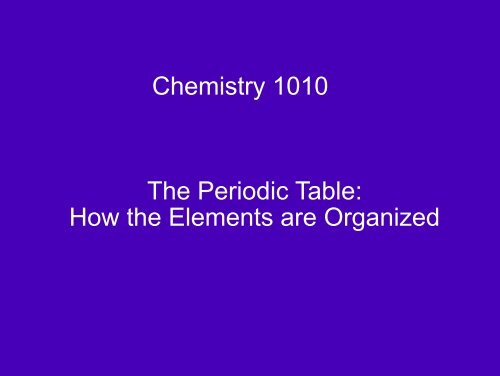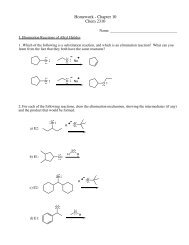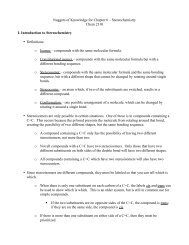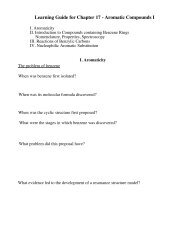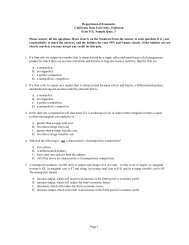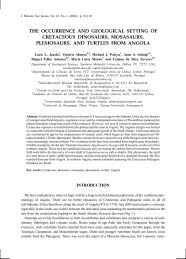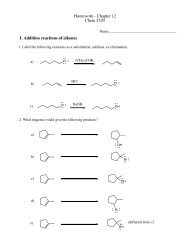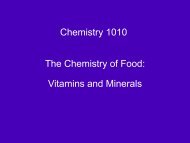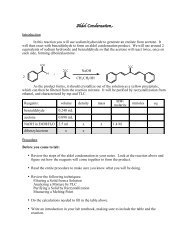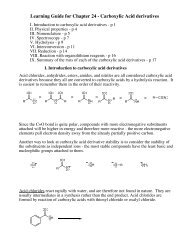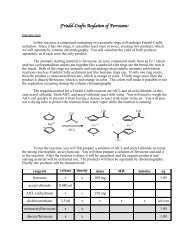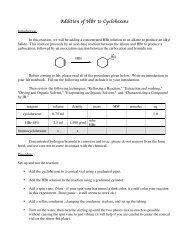Chemistry 1010 The Periodic Table - Dixie State College
Chemistry 1010 The Periodic Table - Dixie State College
Chemistry 1010 The Periodic Table - Dixie State College
- No tags were found...
You also want an ePaper? Increase the reach of your titles
YUMPU automatically turns print PDFs into web optimized ePapers that Google loves.
<strong>Chemistry</strong> <strong>1010</strong><strong>The</strong> <strong>Periodic</strong> <strong>Table</strong>:How the Elements are Organized
ReviewName some elements that you remember from the previouslecture, and what you remember about them.gold and copper are the only metals that aren't grayWhere do the names of the elements come from?from names of substances, what they were found in,mythology, scientists, placesWhat are the symbols for the following elements?argon Ararsenic Asastatine Atantimony Sbnickel Nineptunium NpnitrogenniobiumNNb
What is the most common element in the universe?What is next?hydrogen, helium (99.75%)What are the two most common elements onthe earth?oxygen, silicon (75%)What are the four most common elementsin your body?oxygen, carbon, hydrogen, nitrogen (96%)What are the three categories of elements based on what theylook like in their pure form??metals (74) nonmetals (17) metalloids (6) unknown (21)
If a pure element can exist in two or more different forms, whatare these forms called?allotropesHow many elements can be found native (in their pure form innature)?gold, silver, copper, platinum, iron, carbon, sulfur – 7How are the other elements found?in compounds and mixtures
IntroductionTake a good look at the <strong>Periodic</strong> <strong>Table</strong> of Elements that you weregiven. What objective observations can you make about it?
What does each block of the <strong>Periodic</strong> <strong>Table</strong> contain?each block represents one elementatomicnumbersymbolnameatomic mass
Why isn't the atomic mass a whole number?more than one isotope exists in nature99.98% have 1 proton; mass = 10.015% have 1 proton, 1 neutron; mass = 21 in 1018 have 1 proton, 2 neutrons; mass = 3mass of hydrogen found in nature: 1.007What about atoms whose mass is a whole number in parenthesis?for most radioactive elements, the massof the most stable isotope is shown
1. Why did chemists need a new way to organize the elements?<strong>The</strong>re are lots of ways that you could organize a list of elements.How is this list organized?alphabeticallyactiniumaluminumamericiumantimonyargonarsenicastatinebariumberkeliumberylliumbismuthbohriumboronbrominecadmiumcalciumcaliforniumcarbonceriumcesiumchlorinechromiumcobaltcoperniciumcoppercuriumdarmstradtiumdubniumdysprosiumeinsteiniumerbiumeuropiumfermiumfluorinefranciumgadoliniumgalliumgermaniumgoldhafniumhassiumheliumholmiumhydrogenindiumiodineiridiumironkryptonlanthanumlawrenciumleadlithiumlutetiummagnesiummanganesemeitneriummendeleviummercurymolybdenumneodymiumneonneptuniumnickelniobiumnitrogennobeliumosmiumoxygenpalladiumphosphorusplatinumplutoniumpoloniumpotassiumpraseodymiumpromethiumprotactiniumradiumradonrheniumrhodiumroentgeniumrubidiumrutheniumrutherfordiumsamariumscandiumseaborgiumseleniumsiliconsilversodiumstrontiumsulfurtantalumtechnetiumtelluriumterbiumthalliumthoriumthuliumtintitaniumtungstenuraniumvanadiumxenonytterbiumyttriumzinczirconiumadvantage: easy to find an elementproblem: doesn't tell us anything about properties
How was Dalton's 1805 list of elements organized?by massadvantage:you can see whatelements are lighterand which are heavierproblem:you can't predict anyother propertiesHow is the list that I gave you organized?by atomic numberelements go up in mass and atomic number almost identically
As more and more elements were being discovered, chemiststried to find a way to organize them that would show how theirproperties were related.A chemist named Dmitri Mendeleev discovered the key.Eventually he realized that:Mendeleev was a card player. He wrotethe names, masses, and properties of the 63known elements on playing cards andshuffled and dealt them again and again,looking for a good way to organize them.when elements are listed in orderof their mass, their properties are periodic
2. What does “periodic” mean?If something is periodic, then it:has properties with a repeating patternLet's consider some examples of things you are familiar with:numbers, letters, days of the month, temperature, and windspeed.Numbers:0 1 2 3 4 5 6 7 8 9 10 11 12 13 14 15 16 17 18 19 2021 22 23 24 25 26 27 28 29 30 31 32 33 34 35 36 37 etcIs there a pattern to how we write the numbers?yes – 0 to 9 are different, but then it starts over at 10 - 19
How could you make a chart to represent this?If you go across the rows of this table:the first digit is the samethe last digit is in order of sizeIf you go down a column of this table:all of the numbers end in the same digitAre numbers periodic? yes – pattern repeats itself exactly
Letters:A B C D E F G H I J K L M N O P Q R S T U V W X Y ZAre there any repeating patterns in the letters?not reallyWe could make a chart by starting a new row every time there isa vowel.Across the rows: goes up one letterDown the columns: nothing in commonAre the letters periodic? no
Days in a month:Sat, Dec 1Mon, Dec 2Tues, Dec 3Wed, Dec 4Thurs, Dec 5Fri, Dec 6Sat, Dec 6Sun, Dec 7Mon, Dec 8Are there any repeating patterns?How can we make a chart showing this?days of the week repeatrows – dates go across, thencontinue on the next rowcolumns – all the same day of theweekAre days of the month periodic?yes!
Temperature:If you took the outside temperature every three hours for fivedays, what pattern would you see?it would get colder in the night, then warmer in the dayWe can show this by making a graph.the graph shows therepeating patternIs temperature periodic?yes
Wind speed:If you took the wind speed every three hours for five days, whatpattern would you see?there probably wouldn't be oneHere's what the graph would look like:no repeating patternIs wind speed periodic?noGraphs can show whether something is periodic or not.If something is periodic, a table will show a relationship bothacross rows and down columns.
Elements:Here are three graphs showing different properties of theelements.Is there a repeating pattern?yessize of atoms (atomic radius)
first ionization potentialyes
yeselectronegativitySince the elements are periodic, there must be a way to make achart which will make use of these repeating patterns.
3. How does the <strong>Periodic</strong> <strong>Table</strong> show repeating patterns?To show how Mendeleev used the repeating patterns in theelements to create the <strong>Periodic</strong> table, we'll use a set of coloredcards with numbers on them.numbers = mass of the elementcolors = properties of the elementStep 1: Random order (this is like an alphabetic list of the elements)15110 4 11 17 5208 12 21 9 6 18 16 22143197132
Step 2: Arrange the cards in a long row in numerical order(this is like a list of the elements in order of mass)1 2 3 4 5 6 7 8 9 10 1112 13 14 15 16 17 18 19 20 21 22What patterns do you see here?●blue always comes after orange●green is always followed by yellow●purple is always between a blue and a green●yellow always has an orange after it●and so on
Step 3: Turn the row into a table by starting over every timethere is an orange card.12 3 45 6 7 89 10 11 12 1314 15 16 17 1819 20 21 22
Step 4: Slide the cards over so that the columns match up.12 3 45 6 7 89 10 11 12 1314 15 16 17 1819 20 21 22rows:numbers go up by one (may jump across)columns:same color
How does the table you have made compare to the <strong>Periodic</strong><strong>Table</strong> of Elements?rows:increase in both atomic number and masscolumns:elements with similar properties
Draw arrows to show how the atomic number increases:
What's going on with the two rows at the bottom of the table?Here's what the <strong>Periodic</strong> <strong>Table</strong> should really look like:To make the table smaller, they took some elements out of themiddle and made them into two separate rows.
If a new element with the atomic number 119 was created, wherewould it go?119It would start a new row beneath francium.
Rows are called periods.Periods are numbered from the top.1234567What period are the following elements in?beryllium (4)2 nd periodtungsten (74)6 th periodtitanium (22)4 th periodcurium (96)7 th period
Columns are called families or groups.Some families have names.alkali metalsalkaline earthmetalscarbon familyhalogensnoble gasesAll other columns are named afterthe first element in the family.
Elements in the same family have similar properties.Halogensall occur in pure form as diatomic molecules which arehighly reactivefluorine chlorine bromine iodineall form a highly acidic compound with one hydrogen atomand one halogen atomhydrogenfluoridehydrogenchloridehydrogenbromidehydrogeniodide
all form a 1:1 compound with sodium where the halogenhas a -1 chargesodiumfluoridesodiumchloridesodiumbromidesodiumiodideall form a compound with one halogen atom, one carbon atom,and three hydrogen atomsfluoromethanebromomethanechloromethaneiodomethane
noble gasesall occur in pure form as colorless gasesall are highly unreactive, forming few if any compoundswith themselves or other elementsall give off light in gas discharge lamps
alkali metalsall are soft, highly reactive metals in pure formlithiumsodium potassium rubidium cesiumall easily lose one electron to form +1 ionsall react with water to form hydrogen gas (which ignites!)lithium+watersodium+waterpotassium+waterrubidium+watercesium+water
alkaline earth metalsall are reactive silver colored, soft metals(but less reactive and harder than alkali metals)beryllium magnesium calcium stronium bariumall are more dense than alkali metals and melt at very hightemperatures – stay solid in a fireLi 180 o C Na 98 o C K 63 o C Rb 38 o C Cs 28 o C Fr 27 o CBe 1278 o C Mg 650 o C Ca 839 o C Sr 764 o C Ba 725 o C Ra 700 o Call react with water, but not as vigorously as alkali metalsall form compounds with chlorine with a 1:2 ratioLiCl NaCl KCl RbCl CsCl FrClBeCl 2MgCl 2CaCl 2SrCl 2BaCl 2RaCl 2
4. How can the <strong>Periodic</strong> <strong>Table</strong> of Elements be used to predictthe properties of elements?When Mendeleev first published his <strong>Periodic</strong> <strong>Table</strong> in 1869, therewere only 63 known elements, which is only about 2/3 of thenaturally occurring elements.12 36 79 10 1114 16 1720 21 22mass increase downsimilar elements are acrossSo his cards actuallylooked more like this!
Mendeleev used the patterns that he had found to do somethingrather astonishing. When there was a space in the pattern withno element to fill it, he left a space open and predicted that a newelement would be found to fill it.Within a few years, three of these elements were found in nature.1875 ? = 68 gallium (actual mass 69.72)1879 ? = 45 scandium (actual mass 44.96)1886 ? = 70 germanium (actual mass 72.61)1925 ? = 180 rhenium (actual mass 186.2)
Can you predict the cards that are missing in this table?12 345 6 7 89 10 1112 1314 15 16 17 1819 20 21 22 23What else is missing?
Here is what our current table looks like with only the elementsMendeleev knew:What's missing?Sc, Ga, Ge, Re, hafnium (1923)noble gases (1894-1898)radioactive elements (1898-1900)rare earth elements (1878-1901)artificial elements (1939-present)
Let's look at some of the patterns the <strong>Periodic</strong> <strong>Table</strong> reveals.Where are the naturally occurring and artificial elements?naturally occurringartificial43104 1186193 103artificial elements = 43, 61, 93-118
Where are the metals, nonmetals, and metalloids?metalsmetalloidsnonmetalsAtFrSgUuhMdWhat would you guess about the appearance of the followingelements?franciummetalmendeleviummetalseaborgiummetalununhexiummetalastatine nonmetal or metalloid
Here is a visually beautiful <strong>Periodic</strong> <strong>Table</strong> created by <strong>The</strong>o Gray.You can order a 20” x 40” poster for $15 at his website.
How are the metals divided up?main group metals(nonmetals)transition metalsinner transition metals
Where are the solids, liquids, and gases?solidsliquidsgasesCan you predict the physical state of the unknown elements?all solids except Uuo, which is probably a gas


